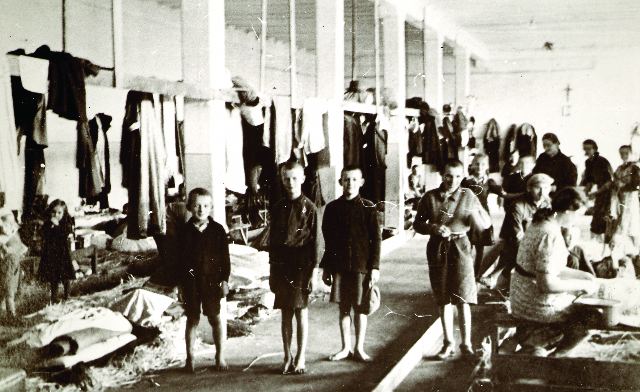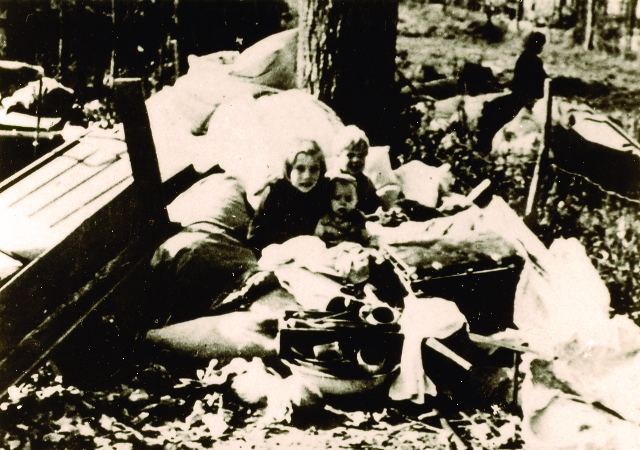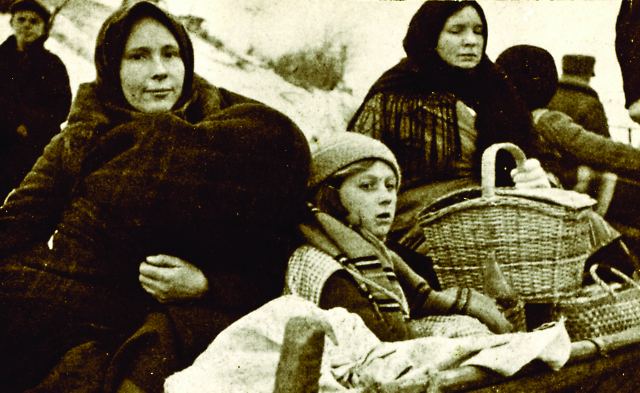The main objective of the policy of Germanisation was to expulse other races from the occupied territories and to settle Germans in their place. There were many ethnic Germans living in other countries, above all in the Baltic States and USSR amongst many others. Heinrich Himmler was in charge of this policy and he gave himself the task of strengthening German national values as he saw them. This led to the extermination of the local population both directly and indirectly.
The first phase of people leaving their homes was during the invasion when refugees fled from places threatened by the Wehrmacht. Once the campaign was over some people returned, others had been killed on the road or in the fighting whilst others did not return home fearing arrest as they had been prominent Polish citizens before the war and thus would be known or because they had participated in revolts against German rule in the aftermath of WW1 such as in Silesia.
Organised expulsions occurred almost immediately as the German army seized territory. This was called ‘wild expulsions’ and was initiated by local authorities. This occurred in areas that were to be annexed in Pomerania, Silesia and Wielkopolska. This was considered to be a strategic necessity. A good example is Gdynia which was close to the port in Gdańsk and where the presence of Poles was thought to carry an element of risk for the Nazis. The day after Gdynia was occupied on 14 September 1939, the arrests and expulsions started. Posters appeared ordering people to leave their homes leaving the keys in the door. Around 50000 people were eventually expelled from Gdynia.
During these ‘wild expulsions’ around 35000 people had lost their homes and were deported to the General Government by the end of November 1939.
In October 1939, German authorities took the decision to expel at least 700000 Poles from Wielkopolska and Pomerania. Due to the huge scale, the operation was carefully planned. On 11 December 1939 a special office for the expulsion of Poles and Jews was opened. It was based in Poznań and within a few weeks a branch office opened in Łódź. On 15 November 1940 another office appeared in Gdańsk. Smaller offices appeared in other towns where they were required by the Nazis such as Zamość.
The main task of these offices was to organise the expulsion of the local inhabitants as quickly as possible. With this in mind, a network of transit camps were opened in which selections took place. The first camp was opened at the end of 1939 in Łódź at ulica Łąkowa 4. This was called the Durchgangslager I der Umwandererzentralstelle Posen, Dienststelle Litzmannstadt (transit camp for the central transfer office, Łódź branch). Expulsees were registered here and sent to the General Government. Later inmates were sent for forced labour in the Third Reich and from 1943 to France too. There were several camps in Łódź, including some for children.

For the Gdańsk Expulsion Offices there were camps at Potulice, Toruń and Smukała. The camp at Potulice initially was for people who were to be sent for industrial and agricultural forced labour in the region of West Prussia. Then small industrial facilities and workshops were opened in the camp itself and it became a work camp. Whole families were sent there. It operated until January 1945.
Expulsions from the Ciechanów region occurred via the camp at Działdowo which from February to May 1940 fulfilled the role of a transit camp for Poles from the areas of Płock, Ciechanów and Białystok. People were sent from the area of Przasnysz too where a military training ground was constructed and the population of whole villages were expelled.
To give an example of how this happened, beginning on 22 September 1940 the inhabitants of the Żywiec region in southern Poland were expelled to the General Government. It was code named ‘Saybusch Aktion’. There was a timetable and the Gestapo had drawn up the list of people to be expelled. All the transports were sent to a railway station in Łódź and from there to the Lublin, Warsaw, Kraków and Radom regions. The operation was completed in January 1941.
Expulsions from the countryside began early in the morning. Families could take up to 15kg with them and they had no more than 15 minutes to pack. Everything else they possessed was taken by German settlers.
Around 860000 Poles were expelled to the General Government in the winter of 1939 – 1940. Around 400000 Germans took their place following the German – Soviet treaty of borders and friendship of 28 September 1939. Later people also came from lands occupied by the USSR in eastern Poland, Lithuania, Latvia, Estonia and Bessarabia.
People were also expelled in the General Government. In 1940‐1941 around 170,000 people from Radom, Dębica and Lublin met this fate as the Germans opened military training areas. Some of these people became forced labourers in Germany. The remainder needed to find new homes by themselves, they received no assistance whatsoever from the occupiers in doing this. The fate of the expulsees was of no interest to the Nazis.

At the end of 1942 the German authorities started a massive campaign of expulsions from the area of Zamość although preparations had begun a year earlier. On 6 – 25 November 1941 a trial had been run of 3,000 people. On 12 September 1942, Himmler ordered that a German settlement area was to be placed here and it would be necessary to expel the locals.

An office was opened in Zamość and camps for expulsees were set up in Zamość and Zwierzyniec. Many people were sent from these camps to Auschwitz and Majdanek. Some were also sent to forced labour in Germany. Some of these people who were incapable of work were sent with the children to the areas of Siedlce, Garwolin, Minsk Mazowiecki and Łuków. In the summer of 1943 the operation was suspended due to the activities of the resistance, escapes and the deteriorating situation at the front.
Over 28,000 people were expelled from the Białystok region in 1942 – 1943. In the summer of 1943, due to increased pressure from the resistance, around 20,000 inhabitants of the Nalibocka Forest region on the Neman river in what is today Belarus were expelled. This had been part of Poland before 1939 and during the Nazi period was assigned to the Lithuanian occupied region.
People were also expelled en masse from areas directly behind the front. In the second half of 1944, the front ran along the rivers Narwia, Vistula and Wisłok and so many Poles found themselves being forcibly moved as Soviet forces stood only a few kilometres away. In this case expulsions were accompanied by violent pacifications.
During the Uprising, people were expelled from Warsaw. Around 500,000 to 600,000 people met this fate. Some were sent to concentration camps, others to forced labour in Germany, some escaped and others were sent to the south of the General Government. This was the only place where the Nazis sought to completely destroy the city and expel all the inhabitants.
Czesław Madajczyk considers that during the war, 1,650,000 Poles were expelled from their homes. These figures are not complete as they do not cover all the territory of Poland before 1939.
Relations